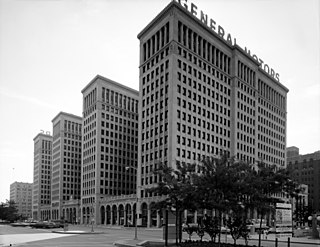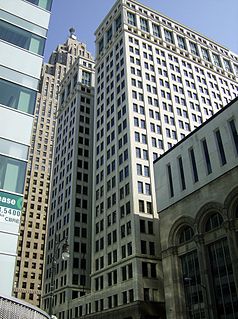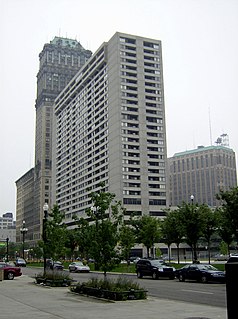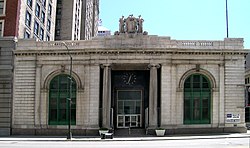
Cadillac Place, formerly the General Motors Building, is a landmark high-rise office complex located at 3044 West Grand Boulevard in the New Center area of Detroit, Michigan. It was renamed for the French founder of Detroit, Antoine Laumet de La Mothe, sieur de Cadillac. It is a National Historic Landmark in Michigan, listed in 1985.

The Greater Penobscot Building, commonly known as the Penobscot Building, is a class-A office tower in Downtown Detroit, Michigan. Constructed in 1928, the Art Deco building is located in the heart of the Detroit Financial District. The Penobscot is a hub for the city's wireless Internet zone and fiber-optic network.

The Cathedral Church of St. Paul is the cathedral church of the Episcopal Diocese of Michigan. In 1824 its congregation formed as the first Episcopal and first Protestant church in the Michigan Territory.

The Buhl Building is a skyscraper and class-A office center in Downtown Detroit, Michigan. Architect Wirt C. Rowland designed the Buhl in a Neo-Gothic style with Romanesque accents. Constructed in 1925, it stands at 26 stories in the Detroit Financial District across Congress Street from the Penobscot Building and across Griswold Street from the Guardian Building, all of which were designed by Wirt C. Rowland. The Buhl Building stands on the corner of Congress St. West, and Griswold St. in Downtown Detroit. The building stands atop what used to be the Savoyard Creek near its confluence with the Detroit River. In 1836, the creek was covered and turned into a sewer. The Savoyard Club occupied the 27th floor of the Buhl Building from 1928 until its membership dwindled and the club closed in 1994.

211 West Fort Street is a 27-story skyscraper in Downtown Detroit, Michigan. Construction began in 1961, and finished in 1963. The building stands at the southeast corner of Fort Street and Washington Boulevard. It was constructed adjacent to the Detroit Trust Company Building, designed by Albert Kahn in 1915, as offices for the Detroit Bank and Trust Company, later known as Comerica. The bank occupied space in the building until 1993, when it moved to One Detroit Center. In the courtyard between the two buildings is a sculpture based on the bank's logo at the time.

1001 Woodward is an office building in Downtown Detroit, Michigan. It replaced the Majestic Building, a 14-story high rise on the same site. The building is located just south of the neighboring David Stott Building, at the corner of Woodward Avenue and Michigan Avenue overlooking Campus Martius Park. Constructed from 1963 to 1965, the 25-story building is designed in the International Style. It was listed on the National Register of Historic Places in 2013.

Chrysler House is a 23-story, 99 m (325 ft) skyscraper located at 719 Griswold Street in Downtown Detroit, Michigan. The class-A office building is adjacent to the Penobscot Building in the heart of the U.S. designated Detroit Financial District. It is used as an office building, with retail space on the street level. It was originally known as the Dime Building but has carried numerous names over the years.

The Penobscot Block is a complex of office towers centered on the 45-story Penobscot Building at the corner of Griswold Street and West Fort Street in Downtown Detroit, Michigan. The buildings on the block are named for the Penobscot, a Native American tribe from Maine.

The Wayne County Building is a monumental government structure located at 600 Randolph Street in Downtown Detroit, Michigan. It formerly contained the Wayne County administrative offices – now located in the Guardian Building at 500 Griswold Street – and its courthouse. As Wayne County Courthouse, it was listed on the National Register of Historic Places in 1975. When it was completed in 1902, it was regarded as "one of the most sumptuous buildings in Michigan".

The Qube, previously known as the Chase Tower, the Bank One Center, and the National Bank of Detroit Building, is a high-rise office building and Quicken Loans operations center in the U.S. designated Detroit Financial District at 611 Woodward Avenue, in Downtown Detroit, Michigan. It was built in 1959 and stands at 14 floors in height. It was completely remodeled in 2011 and is currently in the process of remodeling again. It was designed in the modern architectural style, and uses a great deal of marble to coordinate with the buildings in the nearby Civic Center. It was designed by Albert Kahn Associates.

Fort Washington Plaza is located at the corner of West Fort Street and Washington Boulevard in downtown Detroit, Michigan. It occupies the entire block bordered by West Fort Street, Washington Boulevard, Cass Avenue, and West Congress Street. The high-rise office building stands 16 stories in height. It was built in 1969, and includes a parking garage. It was designed in the international architectural style. It uses mainly concrete and glass.

The Vinton Building is a residential high-rise located at 600 Woodward Avenue in Downtown Detroit, Michigan. It stands next to the First National Building, across Woodward Avenue from Chase Tower and the Guardian Building, and across Congress Street from One Detroit Center. It was designated a Michigan State Historic Site in 1982 and listed on the National Register of Historic Places in 1983.

Detroit City Apartments is a high-rise in downtown Detroit, Michigan. Built in 1981 and named Trolley Plaza for nearby Washington Boulevard trolley line, the residential building stands 28 stories tall. The building is located at 1431 Washington Boulevard and occupies the block bordered by Clifford Street, Grand River Avenue and Washington Boulevard. In 2009, Village Green purchased the building and changed the name of the high-rise apartments to Washington Square. In 2013, Washington Square became the Detroit City Apartments.

The Bankers Trust Company Building is an office building located at 205 West Congress Street in Downtown Detroit, Michigan, within the Financial District. Designed by Wirt C. Rowland of Smith, Hinchman & Grylls and completed in 1925 the ornately modeled building is an exquisite example of Italian Romanesque Revival architecture.

The Wright–Kay Building, originally known as the Schwankovsky Temple of Music, is one of the oldest buildings in downtown Detroit, Michigan. It is located at 1500 Woodward Avenue, at the corner of Woodward and John R. Street, in proximity to the Lower Woodward Avenue Historic District. The building was listed on the State of Michigan's Historical Register in 1980 as #P25241.

Fort Shelby was a military fort in Detroit, Michigan that played a significant role in the War of 1812. It was built by the British in 1779 as Fort Lernoult, and was ceded to the United States by the Jay Treaty in 1796. It was renamed Fort Detroit by Secretary of War Henry Dearborn in 1805.

The Federal Reserve Bank of Chicago Detroit Branch Building is a bank building located at 160 West Fort Street in downtown Detroit, Michigan. It was listed on the National Register of Historic Places in 2008.

The Savings Bank Building is a commercial building located at 101 South Front Street in Marquette, Michigan. It is also known as the Marquette County Savings Bank. The building was designated a Michigan State Historic Site in 1976 and listed on the National Register of Historic Places in 1978.

The Detroit Financial District is a United States historic district in downtown Detroit, Michigan. The district was listed on the U.S. National Register of Historic Places on December 14, 2009, and was announced as the featured listing in the National Park Service's weekly list of December 24, 2009.

The United Way Community Services Building is a high-rise office building completed in 1895 at 1212 Griswold Street, at the northeast corner of State Street, in the Capitol Park Historic District of downtown Detroit, Michigan. The 48.77 m (160.0 ft) 12-story building was designed by architects Spier & Rohns and was the tallest in the state when built. The lower two floors are faced with a brown rusticated stone with the main entry centered on the south façade and framed by four square pilasters of gray granite. Floors three through five are smooth stone and floors six through twelve are tan brick. The structure originally had an elaborate cornice surrounding the twelfth floor which was removed in the 1950s. The light court which extended from the fifth to twelfth floor above the entry was filled in 1988 and faced with glass and a gabled glass roof to provide additional office space.
























